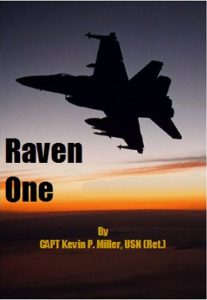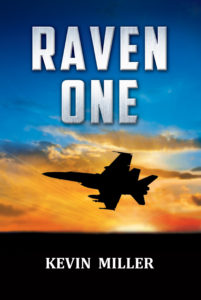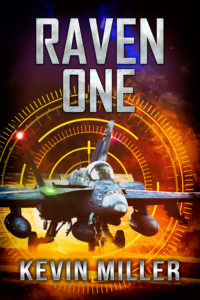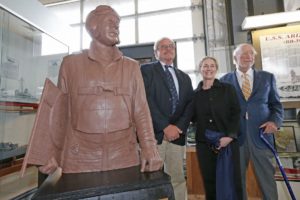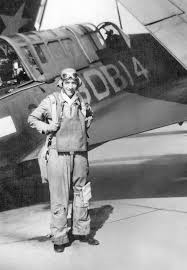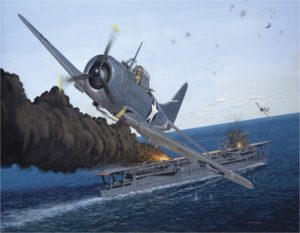Fighter Sweep Interview
My friend and fellow aviator and author Paco Chierici interviewed me in Fighter Sweep dot com. Look for Paco’s novel Lions in the Sky next year!
Naval Aviation Author has Serious Chops in the Cockpit and on the Page
You Can (and do) Judge a Book by its Cover
This chestnut of the publishing industry is instinctive for readers. We walk past the bookshelf at a supermarket or airport bookstore and our eye scans dozens of images before they are drawn to one that we seek. If you are looking for military action adventure, your subconscious will reject the pastel colors (flesh tones?) and soft fonts of romance novel covers and pass them by, looking for bold colors and sharp fonts that invoke machines and danger. Our brains filter for us in nanoseconds, and retailers help us by organizing their shelves for our tastes.
Research shows that a bookstore browser will spend eight seconds evaluating a cover; on line this is less, and a literary agency has a policy of three seconds for the cover to “grab” them before they pass. On your mobile device the cover image is 58 pixels square. The cover, and title, must be effective and hold attention for over three seconds.
I knew Raven One was a good title; I think Hollywood co-opted it for Rogue One, but let’s move on. My vision for the cover was a FA-18 Hornet silhouetted by a setting – or rising – sun. This would invoke drama, purpose, an image of a menacing fighter high above. That image and a cool title would convey to the reader that this book is about fighter combat. It is about much more, but a simple yet striking image would push people to give an unknown author a chance. There are plenty of terrific images on Google and my gut told me they are not for the taking. Later research confirmed they are not.
My publisher Jeff Edwards asked me if I had a cover design, and I sent him this:
He hated it.
He had me go to 99Designs and hold a “book cover contest.” After giving guidance, 99Designs then put the word out to designers around the world and within hours I had dozens of designs to choose from, and over the next several days, hundreds. Holding on to my original vision for the cover, I directed the designers toward it. I then made what may have been a tactical error.
99Designs allows contest holders to conduct a poll, and so I asked people in my circle, from all walks of life, to comment on a short-list of designs I thought had merit. My hope for Raven One is that it can appeal to all, and it can, but it is certainly in the military action-adventure thriller genre. I’ve read novels from westerns to young adult to romance to mysteries to techno-thrillers, and if people that prefer these genres read just one military action novel in their life, my hope was and remains that it would be mine. The comments I got were all over the place, and the cover I preferred was not among the top two. It was a struggle, and after agonizing for days I went with Dima Li, of Kiev, Ukraine.
This cover showed a single jet in an angle of bank with weapons on the wings, dark and mysterious, with a dramatic sky. The reader knows this is book is going to be about modern fighter combat, and the title font is powerful, my name is simple. It was an effective cover; Raven One has sold over 20,000 copies in all formats over three years, rising to the Top 100 of all Kindle Paid and all Kindle Free.
Through reviews and feedback I’ve learned that 80% of my readers are male. And they skew older – frankly this is the future of publishing with fewer and fewer readers each year as fewer and fewer young people turn to it as a form of entertainment. My books convey to the reader what it is like in today’s military and explain geopolitical realities in a way that entertains without overwhelming, but after giving copies to young readers with heartfelt requests to give it a try – with few exceptions they do not.
So when it became time to update Raven One’s cover to make it more alluring to the next level – read Hollywood and video game designers – we knew we had to go with the ones who brought, or bought, us. Braveship’s Jeff Edwards, an accomplished military techno-thriller author, thought the R1 cover was like an airline brochure but he shrugged his shoulders and let me choose. This time I brought Jeff in on the process. Once again holding a contest with 99Designs, together we put down the guidelines for the designers. This book is about aircraft carrier aviation with lots of drama and action. We envisioned a dramatic night carrier catapult launch, with energy, power, mystery, danger. We wanted a powerful font, and one that we can use for future books as a brand. We began our contest and the designs came in, but much slower than three years ago. The designers did not seem to be reading the detailed brief, and the quality out of the gate was lower than expected. Alarmed, I extended the contest and 99Designs could not have been nicer in accommodating my requests. They were impressed that four master designers and three excellent ones were competing. That made me feel a little better, but it was also troubling with the low numbers of designs. The contest progressed and this time Jeff and I did not conduct a poll, but if we did we would have requested input from people in our circles who actually read military genre fiction. The question is simple: would you buy this book?
After the first round we identified designer ZamajK as a dark horse with potential, and he was most receptive in tweaking his design to meet our requests. He came on strong, and his Photoshop talents are remarkable. Below is his winning cover. To convey the dazzling white afterburner behind the jet, he illuminated the jet blast deflector, and did a terrific job with the aircraft external lights. The steam swirling about also conveys the power of the launch, and the night sky invokes drama. The “targeting reticle” suggests combat, and you can just feel the jet hurtling down the track…where is it going? What will happen next? Raven One is a multi-faceted story of men and women in a carrier fighter squadron, a story of jealousy and resentment, determination and courage, but you only get one cover image to draw people in for over three seconds. ZamajK, who is from Sweden, produced a cover that can increase the understanding of what Raven One is about.
Now, the cover of Declared Hostile shows a Super Hornet shooting a Maverick missile at a boat in broad daylight. What is going on with that? Actually, a better question is; would you buy the book?
George Walsh; 96 years young
At the far right is my friend and fellow aviator George Walsh at the Buffalo and Erie County Naval and Military Park, standing with Phillip McClusky, the son of Battle of Midway hero Wade McClusky. Between them is sculptor Susan Geissler at the dedication of the statue she produced to honor and remember what Buffalo native McClusky did 75 years ago.
More than anyone else, George made this long overdue recognition of McClusky by his own hometown a reality. George is a man who gets things done.
When World War II broke out, George left his home in Flatbush and like so many hundreds of thousands and millions of American kids went into the service. George became a Navy carrier pilot, and by 1944 was deployed aboard USS Ticonderoga flying the front line SB2C Helldiver dive bomber as part of Bombing Squadron Eighty. When a kamikaze ripped through Tico only 20 feet from his squadron ready room killing six of his fellow aviators, he and the survivors of VB-80 went over to USS Hancock to continue their combat sorties against a determined enemy. Men like George didn’t let off the gas in the war against Japan one bit.
After the war like so many others of the Greatest Generation, George made his way in the world. He married and went into Madison Avenue marketing. He had his own marketing firm, and told me his biggest client was Barbasol Shaving Cream. George was working in Manhattan in advertising in the 1960’s, during the time depicted on the old “Mad Men” series. I asked him if he ever watched the show and he said no – why would he want to watch bad behavior and images like that? He said his time on “Madison Avenue” was not like that.
He sold his firm and went into investment advising, along the way fathering four children who were successful in life and blessed him with seven grandchildren. He was a leader in his community of Darien, Connecticut, and we can think of him like those Billy Joel sang about:
…our fathers fought the Second World War
Spent their weekends on the Jersey Shore…
Along his life’s journey he had his share of disappointment. His loving wife passed away years ago, and he suffered a stroke. He offered me a drink once and I asked if he was going to have one. “No, I’ve already had my lifetime supply,” he smiled.
I met him through fellow Battle of Midway enthusiast Will Dossel whom many of you know through his nom-de-guerre Steeljaw Scribe. Five years ago I visited George in his spacious Darien home in a wooded neighborhood, not far from the waterfront, where he raised his handsome family. Evidence of a life well lived.
He brought me to his study, and I was stunned with what I saw. Dark wood shelving was covered with books about naval aviation, many I recognized and many I did not. George had a blog, still does, and what he writes about is the Battle of Midway. He knows of what he writes.
George knows that it was dive-bombers, led by CAG Wade McClusky of Enterprise – and by Commander Max Leslie of Yorktown – that found and destroyed three of four Japanese carriers in the waters off Midway on June 4, 1942. That afternoon Enterprise dive bombers went back and sank a fourth. George writes that throughout the Pacific War it was dive bombers, not submarines or big gun ships, that accounted for more Japanese naval tonnage than any other weapon system. He’s analyzed the decision matrix of leaders in Makalapa Hill and on the carrier bridges. There were all kinds of SNAFU’s – to be kind – on the American side during that battle and even though we knew exactly where the ships would be and even the names of the ships we still almost blew it. McClusky – and Leslie – saved our bacon that morning.
George laments the cover ups involving our poor torpedoes, the track taken by Hornet’s Air Group, the unfair attention given to the torpedo bombers (which I too am guilty of), the wrong decisions of RADM Fletcher and the continued refusal of the Navy to open up the sealed records of Midway. After 75 years it is still not available to the public. Why, he asks. I’d like to know too. All of us want an accurate record from which to study.
George moved out of his home not long after I visited. He moved into an assisted living facility where he still blogs and – at age 96! – wrote and published a book about Midway. The Battle of Midway: Searching for the Truth
Also during this time he has spearheaded the effort to recognize McClusky – who received a Navy Cross and Purple Heart for his actions at Midway – to be awarded the Medal of Honor. When you read of McClusky’s actions, I too believe it is warranted. It is George, quite hale at 96, who speaks about Midway and its place in world history, and the place of the dive bomber in naval history. It is not sour grapes or resentment. George is a man of action, and he wants to see his fallen comrades receive their due and set the record straight.
It was George, more than anyone else, who made the ceremony in Buffalo a reality, giving the public and local schoolchildren a hero to emulate and be proud of.
Who knows how many carrier based dive bomber pilots from World War II are left. “To what do you attribute your long life?” I asked him at his kitchen table. He thought for a moment, and answered simply. “Luck.”
If you have an interest in Midway, get George’s fascinating book. Find his blog to learn about how Midway shaped the world and McClusky’s part in it. Smile that men like George stepped up to fight totalitarianism 75 years ago, and came home to build up our society to even higher heights.
Lieutenant Commander George Walsh – Warrior, Leader, Friend.
The Meaning of Midway
This weekend we celebrate the 75th anniversary of the Battle of Midway fought June 3-6, 1942, one of the most momentous battles in world history and an American victory that shaped the world we live in today. That’s right, it shaped the world we live in today and guaranteed freedom for hundreds of millions of people.
I won’t hold my breath for commemorative media coverage that say, a D-Day or Hiroshima anniversary would garner. In my youth I recall the three major networks remembering Pearl Harbor every December 7th, the way the networks reflect on 9-11 every September 11th (and no other days). We like milestone numbers like 50th or 75th anniversary, or this year’s 100th anniversary of the U.S. entry into World War I. Next year will be the 100th anniversary of the end of World War I, the “war to end all wars” that most in our society have no idea why was fought or even where.
Normandy, or Gettysburg, Yorktown, Fort McHenry, Pearl Harbor…are visited by hundreds of thousands each year featuring modern museums with interpretive displays and tour guides that can bring these battlefields to life for families and schoolchildren in a way that imbues meaning to the sacrifice that occurred there. Normandy was where Europe (western Europe, unfortunately) was liberated from tyranny, and Yorktown was where a fledgling republic broke free to form of government of the people. We can walk the grounds and learn of human stories, inspirational stories of daring and pitched battles, and come away with a greater understanding of our history.
On the other hand, Midway Atoll, where the turning point battle of the Pacific War was fought, is one of the most inaccessible places on earth, 1,000 miles northwest of isolated Hawaii. The atoll, run by the U.S. Park Service, requires special permission to visit and one should expect the first answer to be no. The two main islands (Sand and Eastern) have many buildings (and scars) remaining from that day Japan attacked it on June 4, 1942. The geographic coordinates of where the carrier duel was fought, a patch of water where four Imperial Japanese Navy aircraft carriers and one U.S. flattop were sunk is some 200 miles north of the atoll, a desolate wilderness of water that has nothing but floating plastic debris from Asia and an occasional merchant ship stacked with containers full of trinkets or automobiles for customers on either side of the vast Pacific.
At Midway, the United States turned the offensive Imperial Japanese Navy into a defensive one. By holding and winning at Midway, the Pacific playing field was now even, allowing Roosevelt’s “Europe First” strategy to proceed. It allowed us to land at North Africa later in the year and keep the Germans pinned down there and on their southern and eastern fronts for two years before we could mass forces for D-Day. It had effects on how Soviet Russia behaved, and on how Europe was shaped post-war. It is not a stretch to consider that all of Europe could have fallen under Soviet domination were it not for the American victory at Midway.
Most of this is lost on Americans and I would imagine Europeans. Midway rates a mention in American high school history texts, but only a sentence in the one-paragraph account of the Pacific War, buried under pages of guilt-ridden meanings of atomic destruction at Hiroshima and Japanese internment in California.
Everything is political these days, and that is no less true regarding the inter and even intra-service rivalries of who really won the battle. Without taking anything away from the services and ship and aircraft types that fought at Midway, it is irrefutable that Navy carrier-based dive bombers delivered the killing blows, and Midway is arguably the finest hour for Naval Intelligence and Crypto-analysts. But Navy surface, sub-surface, and aviation communities (Marine aviation, Army Air Corps/USAF) still throw elbows at each other to claim glory. To his credit former CNO Jay Johnson designated each June 4 as a day to remember the meaning of Midway and reflect on a hard won and heroic victory. Unfortunately, because the public cannot visit Midway and due to an unclear message from two if not three armed services, the history and meaning of this pivotal battle are lost to most.
Linked here is a You Tube video of a talk I gave at the National Naval Aviation Museum in Pensacola during the Centennial of Naval Aviation year 2011. Hope you enjoy it and can learn something of the men who fought this remarkable battle and why, and why it is so important to world history. As an aside, today in the local Pensacola newspaper is a listing of classic movies to be shown this summer at the iconic Saenger Theater on Palafox Street. All worthy films, even 1987’s The Princess Bride. The movie Midway, filmed in 1975 on location in Pensacola, the Cradle of Naval Aviation, about the heroic crews who trained in Pensacola and likely viewed shows at the Saenger in the 1930’s, is missing. The editors may be forgiven – nobody taught them about Midway.
